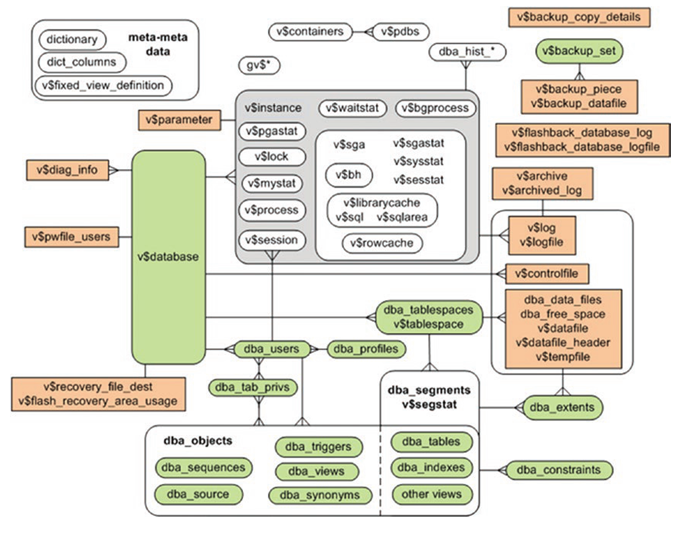A Different View of Metadata- Data Dictionary Fundamentals-2
Logical objects are viewable from SQL only after the database has been started. In contrast, physical objects can be viewed via OS utilities even if the instance is not started.
Figure 10-3 does not show all the relationships of all logical and physical aspects of an Oracle database. Rather, it focuses on components that you are most likely to encounter on a daily basis. This base relational diagram forms a foundation for leveraging Oracle’s data dictionary infrastructure.
Keep an image of Figure 10-3 open in your mind; now, add it to Figure 10-4.

Figure 10–4. Relationships of commonly used data dictionary views
Voilà, these data dictionary views map very closely to almost all the logical and physical elements of an Oracle database. Figure 10-4 does not show every data dictionary view. Indeed, the figure barely scratches the surface. However, this diagram does provide you with a secure foundation on which to build your understanding of how to leverage the data dictionary views to get the data you need to do your job.
The diagram shows the relationships between views, but it does not specify which columns to use when joining views together. You will have to describe the tables and make an educated guess as to how the views should be joined.
Use the diagram as a guide for where to start looking for information and how to write SQL queries that will provide answers to problems and expand your knowledge of Oracle’s internal architecture and inner workings. This anchors your problem-solving skills on a solid foundation. Once you firmly understand the relationships of Oracle’s logical and physical components and how this relates to the data dictionary, you can confidently address any type of database issue.
Note there are several thousand CDB/DBA/ALL/USER static views and more than 900 V$ dynamic performance views.
A Few Creative Uses of the Data Dictionary
In every chapter of this book, you will find several SQL examples of how to leverage the data dictionary to better understand concepts and resolve problems. Having said that, it is worth showing a few offbeat examples of how DBAs leverage the data dictionary. The next few sections do just that. Keep in mind that this is just the tip of the iceberg: there are endless number of queries and techniques that DBAs employ to extract and use data dictionary information.
Leave a Reply